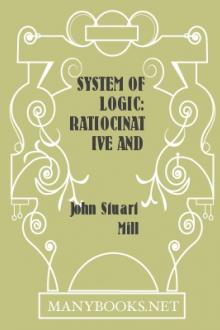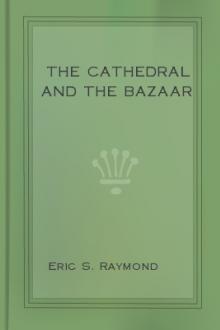A System of Logic: Ratiocinative and Inductive, John Stuart Mill [best books to read now .txt] 📗

- Author: John Stuart Mill
- Performer: -
Book online «A System of Logic: Ratiocinative and Inductive, John Stuart Mill [best books to read now .txt] 📗». Author John Stuart Mill
§ 4. The considerations now stated remove a serious difficulty from the view we have taken of reasoning; which view might otherwise have seemed not easily reconcileable with the fact that there are Deductive or Ratiocinative Sciences. It might seem to follow, if all reasoning be induction, that the difficulties of philosophical investigation must lie in the inductions exclusively, and that when these were easy, and susceptible of no doubt or hesitation, there could be no science, or, at least, no difficulties in science. The existence, for example, of an extensive Science of Mathematics, requiring the highest scientific genius in those who contributed to its creation, and calling for a most continued and vigorous exertion of intellect in order to appropriate it when created, may seem hard to be accounted for on the foregoing theory. But the considerations more recently adduced remove the mystery, by showing, that even when the inductions themselves are obvious, there may be much difficulty in finding whether the particular case which is the subject of inquiry comes within them; and ample room for scientific ingenuity in so combining various inductions, as, by means of one within which the case evidently falls, to bring it within others in which it cannot be directly seen to be included.
When the more obvious of the inductions which can be made in any science from direct observations, have been made, and general formulas have been framed, determining the limits within which these inductions are applicable; as often as a new case can be at once seen to come within one of the formulas, the induction is applied to the new case, and the business is ended. But new cases are continually arising, which do not obviously come within any formula whereby the question we want solved in respect of them could be answered. Let us take an instance from geometry: and as it is taken only for illustration, let the reader concede to us for the present, what we shall endeavour to prove in the next chapter, that the first principles of geometry are results of induction. Our example shall be the fifth proposition of the first book of Euclid. The inquiry is, Are the angles at the base of an isosceles triangle equal or unequal? The first thing to be considered is, what inductions we have, from which we can infer equality or inequality. For inferring equality we have the following formulæ:—Things which being applied to each other coincide, are equals. Things which are equal to the same thing are equals. A whole and the sum of its parts are equals. The sums of equal things are equals. The differences of equal things are equals. There are no other original formulæ to prove equality. For inferring inequality we have the following:—A whole and its parts are unequals. The sums of equal things and unequal things are unequals. The differences of equal things and unequal things are unequals. In all, eight formulæ. The angles at the base of an isosceles triangle do not obviously come within any of these. The formulæ specify certain marks of equality and of inequality, but the angles cannot be perceived intuitively to have any of those marks. On examination it appears that they have; and we ultimately succeed in bringing them within the formula, "The differences of equal things are equal." Whence comes the difficulty of recognising these angles as the differences of equal things? Because each of them is the difference not of one pair only, but of innumerable pairs of angles; and out of these we had to imagine and select two, which could either be intuitively perceived to be equals, or possessed some of the marks of equality set down in the various formulæ. By an exercise of ingenuity, which, on the part of the first inventor, deserves to be regarded as considerable, two pairs of angles were hit upon, which united these requisites. First, it could be perceived intuitively that their differences were the angles at the base; and, secondly, they possessed one of the marks of equality, namely, coincidence when applied to one another. This coincidence, however, was not perceived intuitively, but inferred, in conformity to another formula.
For greater clearness, I subjoin an analysis of the demonstration. Euclid, it will be remembered, demonstrates his fifth proposition by means of the fourth. This it is not allowable for us to do, because we are undertaking to trace deductive truths not to prior deductions, but to their original inductive foundation. We must therefore use the premises of the fourth proposition instead of its conclusion, and prove the fifth directly from first principles. To do so requires six formulas. (We must begin, as in Euclid, by prolonging the equal sides AB, AC, to equal distances, and joining the extremities BE, DC.)
First Formula. The sums of equals are equal.
AD and AE are sums of equals by the supposition. Having that mark of equality, they are concluded by this formula to be equal.
Second Formula. Equal straight lines being applied to one another coincide.
AC, AB, are within this formula by supposition; AD, AE, have been brought within it by the preceding step. Both these pairs of straight lines have the property of equality; which, according to the second formula, is a mark that, if applied to each other, they will coincide. Coinciding altogether means coinciding in every part, and of course at their extremities, D, E, and B, C.
Third Formula. Straight lines, having their extremities coincident, coincide.
BE and CD have been brought within this formula by the preceding induction; they will, therefore, coincide.
Fourth Formula. Angles, having their sides coincident, coincide.
The third induction having shown that BE and CD coincide, and the second that AB, AC, coincide, the angles ABE and ACD are thereby brought within the fourth formula, and accordingly coincide.
Fifth Formula. Things which coincide are equal.
The angles ABE and ACD are brought within this formula by the induction immediately preceding. This train of reasoning being also applicable, mutatis mutandis, to the angles EBC, DCB, these also are brought within the fifth formula. And, finally,
Sixth Formula. The differences of equals are equal.
The angle ABC being the difference of ABE, CBE, and the angle ACB being the difference of ACD, DCB; which have been proved to be equals; ABC and ACB are brought within the last formula by the whole of the previous process.
The difficulty here encountered is chiefly that of figuring to ourselves the two angles at the base of the triangle ABC as remainders made by cutting one pair of angles out of another, while each pair shall be corresponding angles of triangles which have two sides and the intervening angle equal. It is by this happy contrivance that so many different inductions are brought to bear upon the same particular case. And this not being at all an obvious thought, it may be seen from an example so near the threshold of mathematics, how much scope there may well be for scientific dexterity in the higher branches of that and other sciences, in order so to combine a few simple inductions, as to bring within each of them innumerable cases which are not obviously included in it; and how long, and numerous, and complicated may be the processes necessary for bringing the inductions together, even when each induction may itself be very easy and simple. All the inductions involved in all geometry are comprised in those simple ones, the formulæ of which are the Axioms, and a few of the so-called Definitions. The remainder of the science is made up of the processes employed for bringing unforeseen cases within these inductions; or (in syllogistic language) for proving the minors necessary to complete the syllogisms; the majors being the definitions and axioms. In those definitions and axioms are laid down the whole of the marks, by an artful combination of which it has been found possible to discover and prove all that is proved in geometry. The marks being so few, and the inductions which furnish them being so obvious and familiar; the connecting of several of them together, which constitutes Deductions, or Trains of Reasoning, forms the whole difficulty of the science, and with a trifling exception, its whole bulk; and hence Geometry is a Deductive Science.
§ 5. It will be seen hereafter[18] that there are weighty scientific reasons for giving to every science as much of the character of a Deductive Science as possible; for endeavouring to construct the science from the fewest and the simplest possible inductions, and to make these, by any combinations however complicated, suffice for proving even such truths, relating to complex cases, as could be proved, if we chose, by inductions from specific experience. Every branch of natural philosophy was originally experimental; each generalization rested on a special induction, and was derived from its own distinct set of observations and experiments. From being sciences of pure experiment, as the phrase is, or, to speak more correctly, sciences in which the reasonings mostly consist of no more than one step, and are expressed by single syllogisms, all these sciences have become to some extent, and some of them in nearly the whole of their extent, sciences of pure reasoning; whereby multitudes of truths, already known by induction from as many different sets of experiments, have come to be exhibited as deductions or corollaries from inductive propositions of a simpler and more universal character. Thus mechanics, hydrostatics, optics, acoustics, thermology, have successively been rendered mathematical; and astronomy was brought by Newton within the laws of general mechanics. Why it is that the substitution of this circuitous mode of proceeding for a process apparently much easier and more natural, is held, and justly, to be the greatest triumph of the investigation of nature, we are not, in this stage of our inquiry, prepared to examine. But it is necessary to remark, that although, by this progressive transformation, all sciences tend to become more and more Deductive, they are not, therefore, the less Inductive; every step in the Deduction is still an Induction. The opposition is not between the terms Deductive and Inductive, but between Deductive and Experimental. A science is experimental, in proportion as every new case, which presents any peculiar features, stands in need of a new set of observations and experiments—a fresh induction. It is deductive, in proportion as it can draw conclusions, respecting cases of a new kind, by processes which bring those cases under old inductions; by ascertaining that cases which cannot be observed to have the requisite marks, have, however, marks of those marks.
We can now, therefore, perceive what is the generic distinction between sciences which can be made Deductive, and those which must as yet remain Experimental. The difference consists in our having been able, or not yet able, to discover marks of marks. If by our various inductions we have been able to proceed no further than to such propositions as these, a a mark of b, or a and b marks of one another, c a mark of d, or c and d marks of one another, without anything to connect a or b with c or d; we have a science of detached and mutually independent generalizations, such as these, that acids redden vegetable blues, and that alkalies colour them green; from neither of which propositions could we, directly or indirectly, infer the other: and a science, so far as it is composed of such propositions, is purely experimental. Chemistry, in the present state





Comments (0)